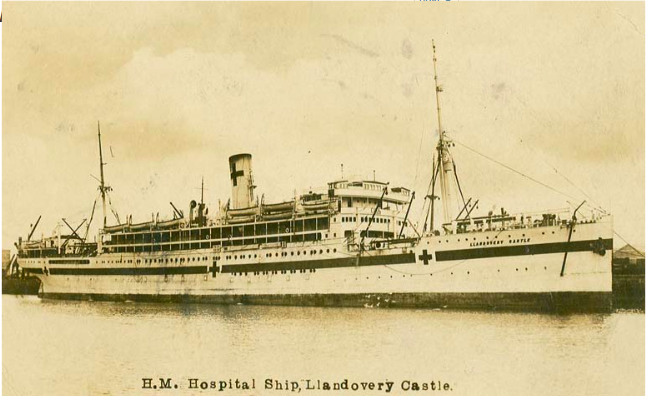
A rallying cry for the Canadian troops - MARY KATHERINE (MINNIE) GALLAHER
MARY KATHERINE (MINNIE) GALLAHER Section 39, Lot 85
Minnie Gallaher was born January 16, 1876 in what is now Kingston, Ontario, the third of 10 children. Her Irish parents, Rev. John Gallaher and Maud Elder, came to Canada after their marriage in 1871. Minnie received her nursing education and graduated from the Lady Stanley Institute for Trained Nurses in Ottawa in 1901.
The Lady Stanley Institute for Trained Nurses was the first nursing school in Ottawa, Ontario, located at the corner of Rideau Street and Wurtemburg Street along the Rideau River. It was founded in 1890 by Constance Stanley, Baroness Stanley of Preston and later Countess of Derby.
She was the wife of Frederick Arthur Stanley, 16th Earl of Derby, who served as Governor General of Canada from 1888 to 1893. On February 18, 1890, at a meeting of representative citizens of Ottawa convened at the City Hall on the invitation of Lady Stanley of Preston, it was suggested the establishment of an institution for training nurses. Lady Stanley's idea of such institution was affirmed and approved by formal resolution.
After graduation, she was in charge of a model hospital set up on the Toronto Exhibition Grounds, and later returned to Ottawa where she worked as the Assistant Superintendent of the Ottawa General Hospital.
She enlisted in the Canadian Expeditionary Force on September 2, 1915 and sailed for Britain September 27, arriving at Shorncliffe, Kent on October 17. Gallaher’s first assignments included the Moore Barracks Hospital and the Westcliff Eye and Ear Hospital.
In January 1916, she was posted to No. 1 Canadian General Hospital in Etaples, France, which at that time was a vast Allied military camp and a giant ‘hospital’ city. Over the course of the next two years, she served at several hospitals and casualty clearing stations at or near the front lines.
On March 25, 1918, Gallaher was posted to HMHS Llandovery Castle, a British merchant vessel turned into hospital ship that had been put at the disposal of the Canadian government to transport sick and wounded soldiers from Britain to Canada. Assignment to a hospital ship was generally regarded as a safe posting in wartime, but sadly, that was not to be the case. After successfully completing four voyages to and from Canada, the Llandovery Castle was torpedoed on June 27, 1918, while sailing from Halifax to Liverpool. The attack came when the ship just off the coast of southern Ireland.
Despite regulation Red Cross lights, and the fact that firing at a hospital ship was against both international law and standing orders of the Imperial German Navy, the ship was deliberately torpedoed by SM U-86. Those who did survive the torpedoing fled to the lifeboats.
 The 14 Nursing Sisters posted to the Llandovery Castle, including Gallaher, were amongst this group. Sadly, Captain Helmut Brümmer-Patzig of the U-86 attempted to cover his crime: he surfaced his submarine, ran down all the lifeboats and executed by machinegunfire survivors. One boat of 24 people escaped notice, and were the only survivors of the 258 people on the ship. The Llandovery Castle became the rallying cry for the Canadian troops during the Last 100 Days offensive.
The 14 Nursing Sisters posted to the Llandovery Castle, including Gallaher, were amongst this group. Sadly, Captain Helmut Brümmer-Patzig of the U-86 attempted to cover his crime: he surfaced his submarine, ran down all the lifeboats and executed by machinegunfire survivors. One boat of 24 people escaped notice, and were the only survivors of the 258 people on the ship. The Llandovery Castle became the rallying cry for the Canadian troops during the Last 100 Days offensive.
The Hundred Days Offensive was a series of attacks by the Allied troops at the end of World War I. Starting on August 8, 1918, and ending with the Armistice on November 11, the Offensive led to the defeat of the German Army.
In terms of the number of deaths, the sinking was the most significant Canadian naval disaster of WW1, and became renowned as one of the war’s worst atrocities.
Minnie was lost and presumed drowned, and as a result, her family was unable to bury her. However, a monument was placed in Gallaher’s honour at her family plot, here in Beechwood Cemetery.
After the war, three officers from U-86, Kapitänleutnant Helmut Brümmer-Patzig, and Oberleutnants Ludwig Dithmar and John Boldt, were charged with committing a war crime on the high seas. On 21 July 1921, Dithmar and Boldt were found guilty in one of the Leipzig War Crimes Trials and were both sentenced to four years in prison. The sentences of Dithmar and Boldt were later overturned on the grounds that they were only following orders and that their commanding officer alone was responsible. Patzig, however, had fled to Danzig, then an independent city, and thus was never prosecuted as a result.
Outside of Germany, the trials were seen as a travesty of justice because of the small number of cases tried and the perceived leniency of the court. According to American historian Alfred de Zayas, however, "generally speaking, the German population took exception to these trials, especially because the Allies were not similarly bringing their own soldiers to justice."

